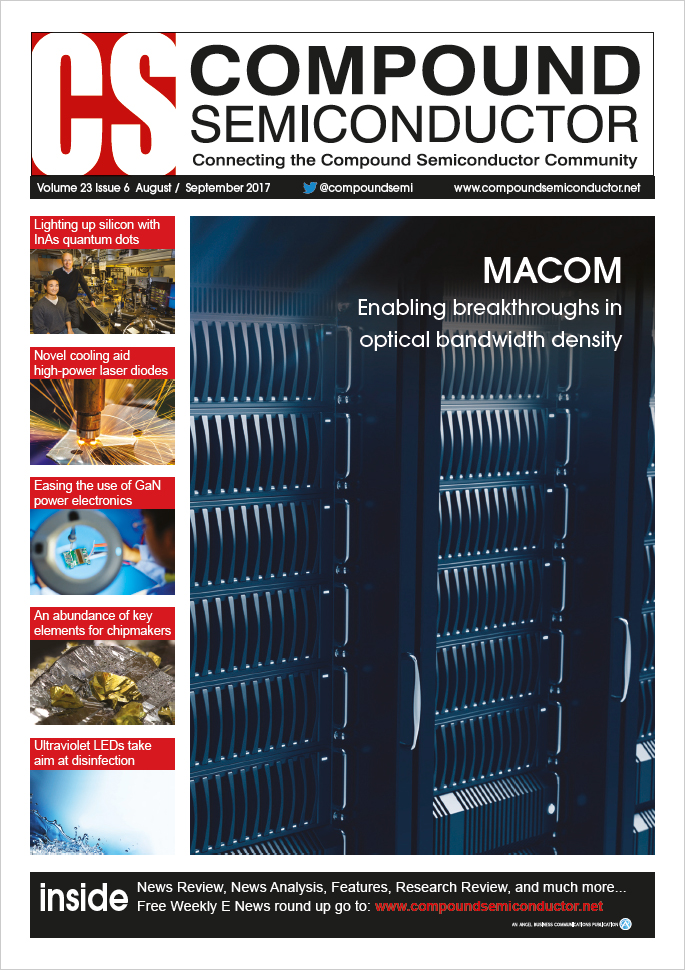
Enabling breakthroughs in optical bandwidth density

Cloud data centres: 10 times to 100 times larger than the opportunity with service providers
Integrated optical components for long haul, metro and cloud data centres are benefiting from excellence in analogue and photonics technology
BY MACOM
The capability of the Internet continues to grow. In its formative years, the Internet was essentially a source of information, providing pages of text and a few images. Fast forward to today, and it is now the place to look for information, images and videos on all manner of things; a great option for buying anything from books to food, to holidays and to homes; and the link to storing data in the cloud.
To cope with the vast and growing number of users of the Internet, and the rising amount of data each of them downloads and uploads, the technology behind it "“ the optical network "“ has to undergo a never-ending increase in capacity.
At MACOM Technology Solutions (MACOM) of Lowell, MA, we are supporting demand by equipping service providers and cloud data centres with high-performance analogue and photonic products. Our solutions deliver breakthrough gains in bandwidth density, and can target a total addressable market for physical layer interconnect components that we estimate to be a $1 billion opportunity for us.
MACOM's portfolio of products in different form factors enables continued improvements in spectral efficiency and reductions in transceiver module size
Long haul and metro
Today's service providers are trying to increase the bandwidth of existing fibre links through improvements in spectral efficiency. Underpinning the move to 100G has been the use of coherent technology, and the continued evolution in dense wavelength division multiplexing, which provides the pathway to 200G, 400G and beyond.
In parallel, service providers are addressing a shortage of rack space and power by deploying increasingly compact, thermally optimized optical transceiver modules. Legacy CFP form factor products are being removed, to be replaced by today's CFP2 and the future-proof CFP4. These are just one-half and one-quarter of the size of their predecessor, respectively.
It is the analogue and photonic technology within these optical modules that determines their size and power requirements, and ultimately their competitiveness. Over the last few years we have made breakthroughs in integration and power efficiency, enabling denser module form factors. These advances have enabled us to establish a leading market position in long haul and metro networks: we estimate that we have secured a 50 percent market share for coherent modulator drivers.
The M37046: Industry leading, four-channel 25G / 28G CDR with integrated limiting amplifier
In long haul, we had our first big breakthrough with our MAOM-003405 driver, the industry's first quad-channel, surface-mount driver for 100G coherent applications. The space and power savings provided by this device have propelled the transition to smaller form factor transponders and higher density line cards, enabling service providers to achieve significant gains in bandwidth density. We continue to build on this success, with our current long haul driver portfolio giving us a 50 percent share in this market.
In the metro market, we broke new ground with the MAOM-03409B modulator driver. It is the first product to meet the size and power consumption requirements of the CFP2 analogue coherent optical (CFP2ACO) module specification, which is today's de-facto standard for metro systems.
The combination of our breakthrough surface mount packaging integration and first-to-market CFP2-ACO support has contributed to a lowering of the cost-per-bit ratio in metro applications. Here, reducing power and size ensures higher port densities, conserving valuable rack real estate. We are now providing a comprehensive range of limiting and linear drivers for QPSK and 16QAM modulation formats, and we are positioned to take more than a 75 percent design-win share in this segment. Shipments of metro products should continue to drive our growth for several years.
We believe we are well positioned for the future, and should extend our market leadership with our breakthrough products, such as the MAOM-006428, the industry's first 64 Gbaud linear modulator driver. It enables data-rates up to 600G. By increasing the data rate on a single wavelength from 100G to 600G, service providers can dramatically increase their bandwidth density while reducing their cost-per-bit.
Thanks to the strengths of our analogue and photonics technology portfolios, we expect sales of our products for long haul and metro networks to total more than $1 billion over the next five years.
Data centres: riding the tsunami
Back in 2015 data centre traffic had almost hit a staggering five trillion gigabytes, according to Cisco's Global Cloud Index, and today it will be even higher. The external traffic that enters the data centre generates a lot of data. For every kilobyte entering the data centre, an estimated 930 kilobytes of internal traffic is generated. Almost 80 percent of that traffic is East-West, or remains within the data centre, where it can contribute to a bandwidth bottleneck.
To handle this tsunami of data traffic, cloud data centre operators such as Amazon, Microsoft, Google and Facebook are rapidly increasing the capacity of their data centres, while boosting connectivity through increases in data delivery speed to 100G, 400G and beyond. Improvement to their key figure of merit, the average per-bit delivery cost, depends on realising space savings, reducing power consumption and lowering the cost in the infrastructure of their data centres.
Consequently, these cloud data centre operators are focusing on maximizing the data throughput per faceplate in their switches, while minimising cost. This effort maximises the bandwidth density, and hinges on the integration of analogue and photonic content within the module, be it a CFP, CFP2, CFP4, QSFP28, OSFP or a QSFP-DD form factor.
Another objective facing the owners of cloud data centres is to maximize the data throughput over their installed fibre in a cost-efficient manner. This is possible with advanced modulation schemes, which are efficient to implement in silicon. One leading option is PAM-4, which increases the amount of data transmitted over each existing fibre connection while reducing the cost per bit significantly.
The MAOM-003401: The industry's first quad-channel, surface-mount driver for 100G coherent applications
To meet resiliency and data redundancy requirements, cloud data centres are linked together via interconnects spanning up to 100 km. These connections are rapidly moving from 100G to 400G, driving a tremendous demand for high-speed, metro-optical links. Here we hold a leading market position in various product categories, including laser drivers, transimpedance amplifiers and clock and data recovery integrated circuits.
Our strong position in this sector is illustrated by our shipment of more than a million 100G modules into data centre and enterprise applications. This number exceeds the largest total addressable market reported by any market analysts to date, and stems from our leadership in long-reach and short-reach laser and VCSEL drivers, CDRs and TIAs. What's even more exciting is that this is just the beginning of a ramp in demand. Over the next four years, volumes of products supporting 100G connectivity within data centres should triple.
We believe that we already have more than a 60 percent share of the high-performance analogue content going into these applications. And this share may increase, as in the second half of this year port shipments into these applications are expected to more than double. Our view is that the growth in the 100G optical market will continue to exceed the forecast of analysts for the next two-to-three years, primarily driven by cloud data centre demand for high-bandwidth connectivity.
The full portfolio from switch to fibre
Building on top of this strong foundation in high-performance analogue content, while drawing on our advanced etched facet technology (EFT), we are optimally positioned to capitalize on the 100G opportunity in cloud data centres. Such a move will replicate the breakthrough we had in reducing costs in passive optical networks "“ this is the world's largest-unit-volume, InP-based laser market. In this cost sensitive market we estimate that we've claimed over a 70 percent share.
The inherent benefits of our EFT are embodied in our portfolio of 25G lasers for 100G cloud data centre applications. By making best use of our in-house, wafer-scale InP manufacturing, we have developed a 25G laser portfolio that is produced with cost and capacity advantages over incumbent laser suppliers. The edge that we enjoy solidifies our industry leadership, and puts us in a great position to support the explosive growth of cloud data centres.
We are now exploiting our EFT laser technology, using it to enable the seamless integration of various optical devices onto a single chip, which can feature lasers, modulators and multiplexers. We are producing the industry's first silicon photonic integrated circuit (PIC), integrated with lasers capable of 100G and beyond. By solving the key challenge of aligning lasers to the silicon PIC with high yield and high coupling efficiency, we have laid the foundation for the adoption of silicon PICs that provide high-speed, high-density optical interconnects in cloud data centres.
MACOM's broad portfolio of flagship products
To strengthen our position, we acquired Applied Micro Circuits Corporation of Santa Clara, CA, in early 2017. This move enables the marriage of APM's PAM-4 100G single-lambda PHY technology, which delivers a four-fold increase in bandwidth density, with our laser-incorporating PIC technology. Combining with the PHY enables a highly streamlined 400G transceiver that quadruples data throughput over existing fibre infrastructure.
One of the key merits of this acquisition is that it creates a portfolio of PAM-4, analogue and photonic technology that positions us for PAM-4 adoption that is not limited to just 100G, but extends to 400G. There are two standards within data centres: to date everything has been NRZ, which is served by our 25G lasers, 100G laser drivers, VCSEL drivers and CDRs; and there is the emerging PAM-4 modulation, a key element moving to 400G. We believe that more than half of the industry will be moving forward with PAM-4 within data centres at 100G. As we incorporate Applied Micro's technology into our own, we will be able to combine our analogue and photonic content for the complete front-end capability, along with the DSP in the PHY with SerDes as well as data converters.
The wisdom of this approach was further advanced by the IEEE, which has unveiled standardization based on a proposal championed by Applied Micro and Cisco to implement single lambda PAM-4 as the industry standard again for both 100G and 400G.
Our expanding product portfolio for cloud data centres encompasses key protocols and spans all formats, giving us the agility to respond quickly to evolving market dynamics. Flagship products are technology agnostic, and can be readily deployed to meet the unique needs of our tier-one customers.
Thanks to our competency in many aspects of cloud data centre connectivity, we have a unique ability to provide customers with the entire optical subassembly. We are able to draw on our portfolio of transmit optical subassemblies and receive optical subassemblies, and this enables us to optimize and validate chip-level semiconductor integration and packaging. If customers lack in-house optical packaging expertise, we can assist them by providing subassembly and/or reference designs. Armed with this, customers can take advantage of our advanced optical components and speed their development of next-generation optical transceivers.
In short, our unique combination of expertise in analogue and photonics technology equips us with an unrivalled ability to provide the seamlessly integrated content required for cost-optimized optical components that light the path from 100G to 400G in long haul, metro and cloud data centres. Our role is to deliver the enabling technologies that allow our customers to lead the industry with breakthrough advancements in bandwidth density. This improves next-generation network infrastructure and transforms global connectivity.































